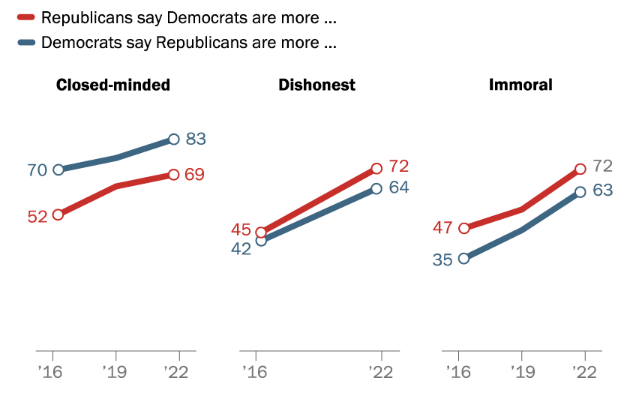Why Is Polarization a Problem? Isn’t it Normal For Us To Strongly Disagree?
“Polarization…is the single greatest weakness of the United States as a country today.”
–Francis Fukuyama
It seems like everyone is talking about toxic division and polarization. In response, you might have wondered, “America has always had a lot of disagreement and conflict. How is this different?”
Or maybe you’ve thought: “But it makes sense for us to be polarized when the ‘other side’ is so horrible and dangerous.” Being divided can seem to make sense when we see “them” as hurting the country or our community, as behaving in authoritarian ways, or whatever it is we see that arouses our anger.
So let’s dig into what people mean when they talk about the problem of polarization.
It’s not about disagreement on issues
When people talk about polarization being a major problem, it’s often affective polarization they’re talking about, not the polarization of beliefs.1 Affective polarization refers to the animosity and contempt people can have for people who disagree with them: the people on the “other side.” (“Affect” in this context refers to emotions.) This can also be referred to as pernicious polarization, us vs. them polarization, or toxic polarization.
It’s entirely normal and expected for us to disagree on issues, and even to disagree strongly and passionately — what is unhealthy and dangerous is the contempt that more and more people have for people on the “other side.”
Us vs. them contempt can in turn influence our beliefs, making this problem even more complex. When we view issues in us vs. them, good vs. evil ways, we’re more likely to be unbending in our stances. We become less likely to want to be like or compromise with the “bad guys.” (One book that examines the complexity of polarization is The Way Out by Peter Coleman.)
Toxic polarization leads to all kinds of dysfunction that impact all of us negatively: loss of trust and connection with our fellow citizens, political gridlock, and more political violence (to name a few things). It creates an environment where we can’t work together to tackle the important problems facing us — and for that reason alone, many people see polarization as our biggest problem.
A dramatic rise in polarization
Many surveys have shown a continual increase over the last few decades in how much animosity Democrats and Republicans have for each other. A 2022 survey showed a big increase over the previous six years in the number of Americans who said people on the “other side” were more immoral, close-minded, dishonest, and lazy (amongst other negative traits) than people in their own group.

And research shows our very negative and pessimistic views of each other are based on distorted and inaccurate perceptions. This includes research showing that many people have an exaggerated view of how many extreme and hateful people are on the “other side.” These views, in turn, make them more contemptuous of the “other side,” and more extreme and hardened in their beliefs.
It’s important to see that this is primarily a problem of too much contempt for each other, not one of political beliefs. Some people hear the goal of “reducing polarization” and think that implies changing people’s beliefs. But that is not what this work is about. This work is about seeing each other more clearly.
Unfortunately, the topic of our distorted views doesn’t get much attention from the media or politicians. One reason is that talking about that would mean acknowledging that people in both political groups play a role in amplifying our divides. In a polarized environment, there can be a pressure on people to not talk about how their own group may be contributing to the problem.
Our contempt is often based on distorted perceptions
Our distorted perceptions of each other is a big subject. If you’d like to learn more, here are a few resources:
- Research on “perception gaps” highlighting our very distorted views about what the “other side” believes.
- Our research showing Americans having a high level of shared values.
- Research showing people have an exaggerated view of how much animosity the “other side” has towards them.
- Daniel F. Stone’s book Undue Hate, which examines the unreasonable levels of dislike we can have for people on “the other side.”
- Research showing antidemocratic beliefs can be caused by perceptions that the “other side” is behaving undemocratically.
- Criticisms that some academic work overstates conservative-side racism.
When we see how distorted our views of each other are, it’s easier to see how our us vs. them narratives drive the cycle of toxic polarization. When we direct contempt and animosity towards the “other side,” they’ll direct it back at us.
Is there a light at the end of the tunnel?
Yes, there is. The future is not yet written. By reducing our own polarizing behaviors — and by pushing back on divisive, dehumanizing, and insulting rhetoric where we find it — we hold the key that will unlock a more healthy, functional, and just world.
If you enjoyed this and want to learn more about the problem of polarization and about our work, please sign up for our newsletter.
1 Political polarization is a complex topic. This piece contains ideas gathered from respected resources and researchers, but you should keep in mind that this, like most complex human problems, is a topic where it’s possible for knowledgable people to disagree about the nature of the problem.
 More
More


 Sign up
Sign up